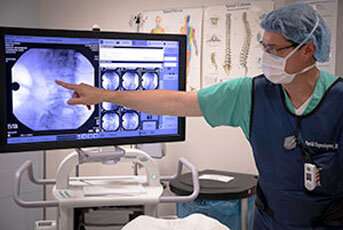Finding non-opioid alternatives for cancer pain

Westey Watson spent 18 years finishing concrete, then another 19 as a contractor—all the while beating up his body to the point of endless pain. To cope, he got in the habit of taking hydrocodone, or Norco, at 10 a.m. and again at 3 p.m. every day just to get the work done.
In 2017, Watson was hit with a type of blood cancer and related spine fractures so excruciating that he wanted to die. That's when doctors added a prescription for long-release morphine to the mix.
Cancer pain, especially when faced by someone with an existing opioid dependence or addiction, can be especially tricky to treat. Until recently, it rarely figured into an overall cancer treatment plan, says UC Davis pain specialist David Copenhaver.
"It's not part of any guidelines," said Copenhaver, chief of the Division of Pain Medicine who runs a pain clinic for cancer patients at the UC Davis Comprehensive Cancer Center and has done research on the guidelines disparity. "It's an existential moment being afflicted with cancer, so there are a lot of reasons we don't talk about it."
Many types of cancer pain
One is that many patients report that their cancer pain is not treated well enough, so doctors may not consider addiction risk when prescribing pain-relieving medicine for them. Another is that giving a patient pain relief, especially if they are not expected to survive their disease, is the compassionate approach, regardless of the potential for abuse or addiction.
Pain in cancer patients can be caused by the tumor itself, pressing on a nerve or organ, for example. It can also be a side effect of treatment, such as in nerve pain after high doses of chemotherapy, or after surgery to remove tumors.
Patients in pain fall into three groups:
- People whose cancer is more like a chronic disease and is well treated, but who should be offered safer, longer-term approaches to pain.
- Cancer survivors who are still being monitored and need to be transitioned off opioid therapy.
- People with active disease but who have a history of opioid dependence, aberrancy or addiction.
Each of these can pose big challenges, Copenhaver said.

New non-opioid treatments available
Even without specific opioid prescription guidelines for cancer patients, Copenhaver uses various pain treatment strategies. These range from blocking nerves and stimulating the spinal cord to injecting steroids and prescribing new drugs that work well against pain but do not lead to addiction.
For Watson's painful fractures, Copenhaver gave him periodic steroid injections into the facet joint in the spine. The facet joint changes when the vertebra collapses and leads to severe pain. "It works pretty good for me," Watson said. "The first time, it lasted 6 months."
But after several injections over two years, the period of pain relief didn't last nearly as long.
"It's constant now," he said in June of about the pain in his back. "It's sharp pain. I can't even bend over. It's throbbing, shooting pain. Sometimes it's hot, pins-and-needles pain."
Ending pain gives cancer patient hope
But Watson, determined not to become an addict, has resisted asking for additional opioid medicines. Instead, he is banking on another approach. For this, doctors use a small, radiofrequency probe with a heating element to block the silk-like fibers that send sensation to the joints and help the spine move.
"This is an old treatment for a new application," Copenhaver explained. "Sometimes patients are too frail for other procedures like surgery. This is a low-risk, high yield approach." The procedure can give patients relief for up to two years.
"We are able to cut the telephone line that communicates pain from the facet joint to the rest of the body," Copenhaver said. "And we are able to reduce the opioid therapy."
In July, Copenhaver's team tested the pain reduction method during a procedure in which they used a needle, guided by an X-ray, to block the nerve. In both cases, Watson felt immediate relief̅, making him an excellent candidate for the actual radiofrequency probe procedure, which is scheduled in early August.
Watson looks forward to an end to the debilitating pain so he can enjoy the time he has, whether it's tending to the tomatoes in his garden or doing odd jobs around his property.
"If it works, I'm good to go for a while," he said. "Hopefully, the relief will last for the time I have left. That would be great."

















